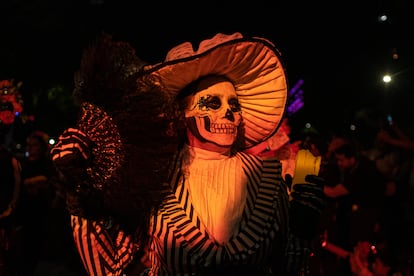The story of La Catrina, a Mexican tradition that began as a social critique
The character, a satirical portrayal of bourgeois society during the late 19th-century dictatorship, is now the iconic symbol of the Day of the Dead

Mexican marigolds (cempasúchil), private altars (ofrendas) and La Calavera Catrina (the Dapper Skull) have become essential symbols of the Day of the Dead, a holiday traditionally celebrated on November 1 and 2 in Mexico. Each year, the elegantly dressed La Catrina skeleton takes the spotlight in parades and costume parties. But the original purpose of La Catrina envisioned by its creator, Mexican printmaker and lithographer José Guadalupe Posada, was to critique bourgeois society during the late 19th-century dictatorship of Porfirio Díaz, when the extravagant silk attire of well-to-do Mexicans starkly contrasted with the harsh reality faced by most of the country.
La Catrina’s original name was la calavera garbancera, a pejorative term for people who denied their Indigenous roots and imitated the European fashions of the day. Posada, who was born in Aguascalientes in 1852, created illustrations and lithographs for the working class. He often used calacas (a colloquial Mexican name for skeleton) to depict the joys and challenges of everyday life, and to satirize those who became wealthy during the 30-year Díaz dictatorship known as the Porfiriato (1876-1911). One of his most memorable prints is a skull wearing a flamboyant French hat embellished with flowers and ostrich feathers. It mocks high-society women who proudly flaunted extravagant fashion accessories, yet were as empty as skeletons inside.
Posada was a highly productive artist who established his Mexico City workshop in 1888, and passed away unnoticed in 1913. Muralist Diego Rivera’s reimagining of Posada’s creations finally brought him the recognition he deserved as one of the foremost figures in Mexican popular art. “Undoubtedly, the Mexican bourgeoisie was terribly unlucky in having the brilliant and incomparable Posada as a critical narrator of its ways,” wrote the muralist about his inspiring predecessor.
In 1946-47, Rivera painted A Dream of a Sunday Afternoon in the Alameda Park, a fresco that featured a fully elaborated figure of La Catrina. The mural was a commission for the Hotel del Prado in Mexico City and features several legendary figures from Mexican history. Rivera gave his Catrina Indigenous features and thus transformed her into a nationalist icon. The elegant skeleton stands in the center, holding hands with its creator — José Guadalupe Posada. “Posada’s greatness is such that his name may one day fade from memory. It has become so deeply rooted in the essence of Mexico that it verges on abstraction. Yet his art and legacy courses through the veins of young Mexican artists, whose works blossom like vibrant flowers in a spring field,” wrote Rivera, who gave Posada’s character her name — La Catrina.
La Catrina transcended art and became a vibrant manifestation of Mexican culture. Affectionately known as la flaca (skinny), she no longer wears European finery, but adorns herself instead in flower diadems, huipiles (traditional Indigenous garments) and the flashy charro outfits of Mexican cowboys. Mexicans have eagerly embraced the spectral figure as a way to find solace and even celebrate the ephemeral nature of life on the Day of the Dead.
Sign up for our weekly newsletter to get more English-language news coverage from EL PAÍS USA Edition
Tu suscripción se está usando en otro dispositivo
¿Quieres añadir otro usuario a tu suscripción?
Si continúas leyendo en este dispositivo, no se podrá leer en el otro.
FlechaTu suscripción se está usando en otro dispositivo y solo puedes acceder a EL PAÍS desde un dispositivo a la vez.
Si quieres compartir tu cuenta, cambia tu suscripción a la modalidad Premium, así podrás añadir otro usuario. Cada uno accederá con su propia cuenta de email, lo que os permitirá personalizar vuestra experiencia en EL PAÍS.
¿Tienes una suscripción de empresa? Accede aquí para contratar más cuentas.
En el caso de no saber quién está usando tu cuenta, te recomendamos cambiar tu contraseña aquí.
Si decides continuar compartiendo tu cuenta, este mensaje se mostrará en tu dispositivo y en el de la otra persona que está usando tu cuenta de forma indefinida, afectando a tu experiencia de lectura. Puedes consultar aquí los términos y condiciones de la suscripción digital.
More information
Archived In
Últimas noticias
Maduro pleads not guilty before the federal court in New York: ‘I am still the president of Venezuela’
A new test can detect Alzheimer’s from a finger prick
UN team enters Sudanese city of El Fasher after paramilitary massacre: ‘It’s like a ghost town’
A recipe for resistance: Indigenous peoples politicize their struggles from the kitchen
Most viewed
- Gilles Lipovetsky: ‘If you want to live better and fall in love, take Prozac, don’t look to philosophy’
- Alain Aspect, Nobel laureate in physics: ‘Einstein was so smart that he would have had to recognize quantum entanglement’
- Alvin Hellerstein, a 92-year-old judge appointed by Bill Clinton, to preside over Maduro’s trial in New York
- Why oil has been at the center of Venezuela-US conflicts for decades
- Maduro’s downfall puts China’s relationship with Venezuela to the test











































